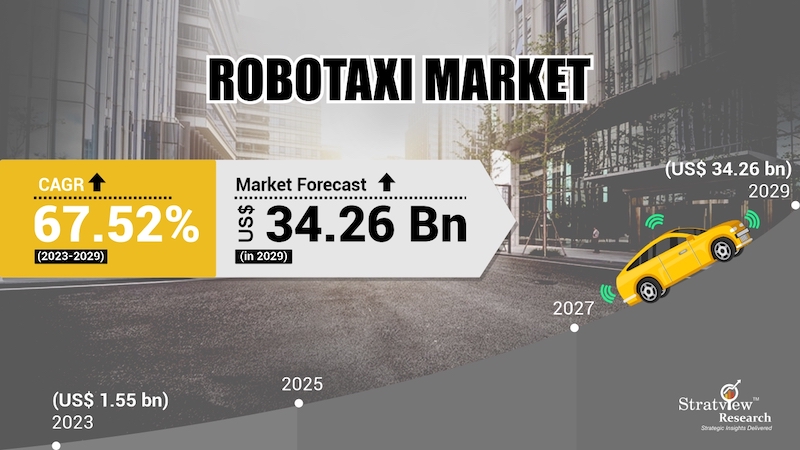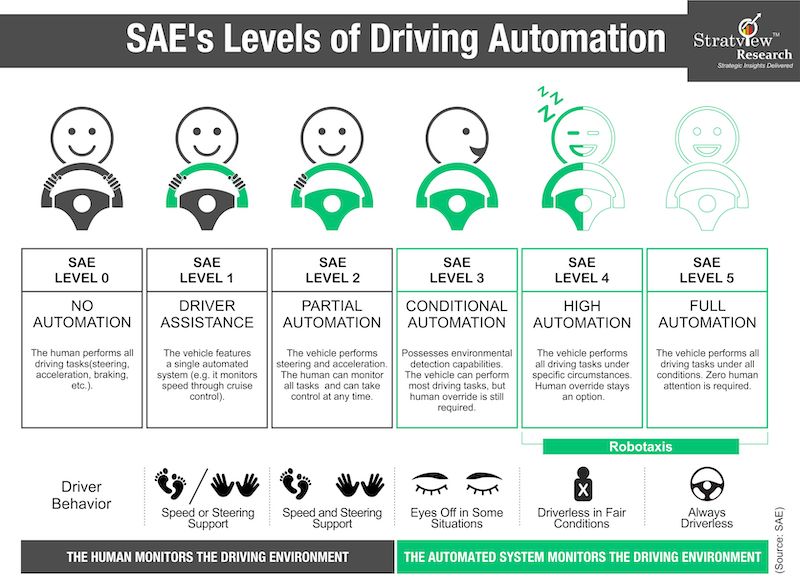Robotaxis: The revolutionary mobility choice of the future
Every 24 seconds, one person dies in a road accident, according to United Nations (un.org) in its road safety fact sheet published in 2021. It is also stated that more than 90 per cent of car accidents occur due to human errors.
Transportation accounted for 37 per cent of CO2 emissions from end‐use sectors in 2021, as per International Energy Agency.
The above figures talk aloud about the two biggest challenges the transportation industry is facing today:
- passenger safety; and
- emissions.
Countries world over are putting efforts in terms of changes in policies, subsidies, incentives, and what not, to put a brake on these two issues which see no signs of abatement in the short time period.
However, the need is immediate to save mankind from their dangerous consequences which have begun to appear expeditiously.
How things can be brought to track? In layman’s parlance, there are three ways things can be brought back on track:
- Reducing the number of vehicles on the road.
- Reducing human dependency.
- Improving fuel efficiency

Robotaxi: An emerging candidate to mitigate challenges
In order to break free of these challenges, the automotive industry is exploring several ways which include lightweighting, improving engine performance and aerodynamics, advancing in alternative-fuel technologies, introducing active safety systems, and making impressive advancements in autonomous vehicle technology.
One such emerging area the industry is exploring is robotic or autonomous taxis, or “robotaxis”. As the word explains itself, robotaxis are self-driven or driverless taxis.
These taxis come in the form of a car or spacious van/shuttle and can be used for transporting goods and passengers. They offer the utmost convenience to humans without their intervention.
When we hear “autonomous” or “self-driven vehicles”, we start imagining cars running out publicly without any human rider. That holds true for most of us, but this is not exactly how the automotive industry defines an autonomous vehicle.
There are certain levels of automation set by the Society of Automotive Engineers (SAE) ranging from 0 (fully manual) to 5 (completely driverless).
Level 0 is completely manual, whereas level1 and 2 refer to manual vehicles with driver assistance features to some extent, such as steering support, break/acceleration support to the driver, and so on.
Level 3 offers autonomous driving support only when the integrated sensors detect the driver’s inattentiveness (or eyes-off in any situation) and alert the driver.
Robotaxis fall under level 4 (L4) and level 5 (L5) where there are no human drivers. However, a human still has the option to manually override the L4 vehicle giving commands, and it can be self-driven. L4 vehicles may have limitations in certain areas/weather conditions and so on.
These vehicles have a limitation on the operational design domain (ODD) and will require human intervention if they encounter any situation outside its ODD.
On the contrary, L5 robotaxis are designed to operate without human intervention in all scenarios, under any conditions, with no set limitations on the ODD.
Passengers cannot take control of the vehicle at any point. However, L5 leverages advanced technologies, and undergoes extensive tests and regulatory approvals to serve the same.
To replace human drivers and make logical decisions on the ground similar to humans, robotaxis rely on various types of sensors, cameras, and other components.
LiDAR (Light Detection and Ranging solutions), RADAR, Trifocal Cameras, and other sensors are vital for deploying a reliable robotaxi. Robotaxis are rapidly advancing with the emergence of 4D technology within their components.
Robotaxis check all the boxes
The advent of robotaxis will redefine the way we travel since they offer multifold benefits just like any autonomous vehicle.
Reducing accidents and traffic congestion
Autonomous vehicles have the potential to mitigate up to 90% of traffic fatalities by eliminating accidents caused by human errors, claims the National Center for Biotechnology Information (NCBI).
Robotaxis offer shared transportation services which results in fewer cars on the road, and reduces congestion, thus contributing to a greener environment.

Cost saving
Robotaxis have the potential of reducing cost per mile as it doesn’t require any driver to provide one extra seat to another passenger. “Fully driverless vehicles help us expand our operation and reduce cost per mile” stated Baidu, an autonomous vehicles manufacturing leader in its 2022 Q4 earnings record.
Reduction in Emission
Though robotaxis can be hybrid, solar-powered, gasoline-powered, hydrogen-powered, or electric, major developments are happening around electric robotaxis. A widescale adoption of e-robotaxis will lead to a significant emission reduction.
Current Status of Robotaxis
At present, the deployment of robotaxis is very limited and is in testing phase mostly with numbers in a few hundred only. However, several companies including OEMs, ridesharing companies, and startups are raising interest and investing in this area.
Let us look at some exciting developments around robotaxis which invokes optimism about their future adoption.
Amazon started testing its Zoox robotaxi, in February 2023, on California’s roads, with employees on board. The group’s full-time employees will be able to use Zoox, which can carry four people a time and can drive at speeds of up to 35 miles/hour.
Two giants, Uber and Waymo (formerly known as the Google self-driving car project) partnered to bring Waymo’s robotaxi to Uber’s platform, in May 2023.
A set number of Waymo vehicles can be seen on the roads later this year (2023), and will include local deliveries, and ride-hailing trips, Waymo mentioned in its release.
Talking about Tesla’s Robotaxi system during the 2022 Shareholders Meeting, CEO Elon Musk said that the group is targeting 2024 for mass production of robotaxi fleet. Tesla robotaxis will not have a steering wheel or pedals, he added.
Hyundai partnered with Motional, a leading autonomous vehicles developer to bring Ioniq 5 Robotaxis (a SAE Level 4 vehicle) on the roads from 2023.
The group is set to launch its first ever electric robotaxi based on IONIQ 5 that is manufactured according to Hyundai’s Electric Global Modular Platform (E-GMP) standards.
Chinese giant – DiDi announced a partnership with GAC AION, a subsidiary of Guangzhou Automobile Group, on May 2023, for the mass production of electric robotaxis named “AIDI”.
The group further adds that the design of its E-Robotaxis will be based on GAC AION’s latest high-end pure electric platform ‘AEP 3.0’ version.
The above list is not exhaustive. Other companies like Baidu, Local Motors, Mobileye (Intel), Drive.AI (Apple), Nissan, and Nvidia are also not left behind in this race.
As the robotaxi industry continues to expand, these companies are rapidly driving advancements in automation levels from being partially autonomous to fully autonomous.
How long is the route towards mass adoption?
Robotaxis are still in their infancy. The realization of robotaxis running on the roads in large numbers is considerably distant. However, the global population is growing rapidly, and with this, grows the demand for transportation solutions.
On the other hand, in order to reduce reliance on critical metals amidst green energy push, the World Economic Forum asks to implement some measures, including the reduction of private vehicles by eliminating ‘ownership’.
The ideal solution to serve these two purposes (growing transportation demand and reducing vehicle ownership) can be adopting robotaxis as soon as possible.
Since most of the world population has already adopted several advances in the active safety systems of their vehicles, adding yet another super-advanced technology doesn’t seem to be impossible.
Why delay? Though robotaxis are beneficial in multiple ways, but the road towards their widespread adoption has not been without some challenges.
To mention a few, the need for high-resolution mapping, the high cost of data processing and storage, regulatory and legal challenges, and public acceptance are the prominent ones.
However, apart from the industry investments being poured into this technology, there are also a few government programs that are encouraging.
China’s Ministry of Transport issued guidelines that encourage the use of autonomous cars in taxi services under certain conditions. Road traffic legislation in Finland has allowed autonomous vehicles to be tried and tested on public roads provided that the tester obtains a road traffic testing permit.
The US Department of Transportation (USDOT) also developed the automated vehicles comprehensive plan to advance the department’s work to prioritize safety.
With only a few robotaxis on the road, the market for robotaxis was just under a billion-dollar mark in 2022, globally. As technology evolves and autonomous driving becomes more reliable and commonplace, it is expected that the global market for robotaxis will grow significantly and cross $34.26 billion by 2029.
The future of transportation is exciting. The way we commute is set to transform and it’s apparent that robotaxis will play a significant role in it.

